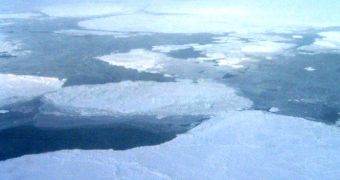Over the past couple of decades, scientists at the American space agency NASA have been working on compiling the most comprehensive record of the onset and termination of Arctic “freeze dates” ever. This means that they kept track of the dates when melting at the North Pole ensued every year, and also of the dates when this stopped. The recently-published results of their analysis are very worrying. It was determined that, on average, the lengths of the melting season in the Arctic increases by as much as 6.4 days per decade, for a total increase of 20 days over 28 years, PhysOrg reports.
Experts reveal that the melt season lasts from April – when the Sun comes up and begins warming the ices and the water around – to September, when ice begins building up again. The process that favors the extension of the melting seasons is unfortunately self-sustaining, experts say. As the winter, sunless months promote the generation of less ice, more water remains behind. The next April, the Sun heats more water, therefore producing more heat, and melting more ice. The same cycle is then repeated over and over again, in a vicious cycle that cannot be easily broken.
“This feedback process has always been present, yet with more extensive open water this feedback becomes even stronger and further boosts ice loss. Melt is starting earlier, but the trend towards a later freeze-up is even stronger because of this feedback effect,” explains expert Thorsten Markus, who is based at the NASA Goddard Space Flight Center, in Greenbelt, Maryland. He is also the author of a new paper detailing these findings, which appears in the latest issue of the respected Journal of Geophysical Research – Oceans. The research carries considerable implications for the future of Arctic waters, analysts believe.
The investigation covers a period extending from 1979 to 2007, which means that 30 years of evolution are caught on tape, so to speak. “Given that the Arctic ocean is nearly twice the size of the continental United States, it would be impossible to track change like this without long-term satellite records,” says NASA cryosphere program scientist Thomas Wagner, who is based at the space agency's Headquarters, in Washington, DC. “Changes in the Arctic sea ice cover may have profound effects on North America’s climate. Studies like this one show us how ice responds to variations in the ocean and atmosphere and improve the predictive models that will help us plan for climate change,” he adds.

 14 DAY TRIAL //
14 DAY TRIAL //